Welcome to the Horus Heresy. With the release of the Age of Darkness and the second edition of the rules, there’s never been a better time to jump into (or return to) a world set 10,000 years before Warhammer 40,000. Over the next few weeks this series is going to take a look at how to build your army, and how those choices you make will affect you on the battlefield.
Horus Heresy has a unique method of army construction that consists of two parts: Force Organisation – built through a detachment – and Rites of War – special rules that introduce bonuses and drawbacks for armies based around how the army operates. While many aspects of army construction are going to look familiar to anyone coming over from 9th Edition Warhammer 40,000, there are some subtle – but substantial – differences.
Force Organisation
Armies in Horus Heresy are made up of units from one of five main battlefield roles:
- HQ units are your leaders and their retinues – powerful warriors who can shape much of how your army will behave.
- Troops fill out the core of your army. They’re typically cheaper and/or larger units than other types and are the only place by default that you’ll find Line units, which you’ll need to control objectives in many missions.
- Elites are your veteran warriors. Terminators in thick armor, near dead marines in powerful dreadnoughts, and squads of legion veterans with flexible weapon options fill a very in-demand role.
- Fast Attack are your mobile forces . Bikes, jetbikes, land speeders, and airplanes give you the ability to rapidly move across the battlefield.
- Heavy Support is full of slower units with lots of firepower – think heavy weapons squads, artillery, and tanks.
There are three other battlefield roles – Primarchs, Lords of War, and Fortifications – but they’re much less common to see. No army using the standard crusade force organization chart will ever have more than one of each of these (and all but the largest games are unlikely to have both a Lord of War and a Primarch).
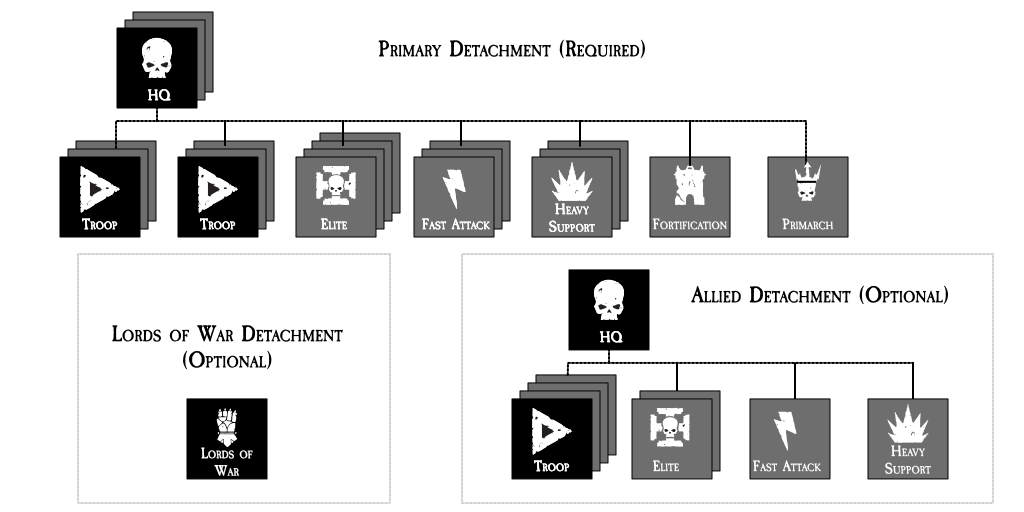
The Horus Heresy doesn’t operate on the same detachment model as Warhammer 40,000. There are only three choices of detachment – a Primary Detachment which you must take, and two optional add-ons that can expand on that Primary detachment in limited ways. Each detachment comprises a mix of Compulsory and Optional unit slots. Every army must have one HQ and two Troops, ensuring that you’ll have a leader and some ability to take objectives… and that you can’t just pile on specialty units. Note that some units can’t be used to fill Compulsory choices – these units have the Support Squad special rule.
Once you’ve filled those required slots you have a number of options to choose from – up to two more HQ choices, four more Troops choices, four Elites choices, and three each of Fast Attack and Heavy support becoming available. There’s also a Primarch slot for larger games where you’ll want to include one.
Expanding on the Primary detachment are an Allied detachment and Lord of War detachment. The Lord of War detachment offers one slot to take a Lord of War, which can be either from the same faction as your Primary detachment or from another friendly one. This is where your biggest war machines and heavy-hitting units will go.
Because they have such massive power and high point costs, Primarchs and Lords of War can only go in games of a specific size – 2,000 points or more – and the combined value of your primarchs and lords of war cannot be more than a certain percentage of your army’s points value – 25%. At 2,000 points this is 500 points, and 600 at 3,000, and so on.
The Allied detachment is a little more complicated. The units in it must be from a different faction than your Primary detachment, and your two forces will interact in different ways depending on how close a bond of kinship they share – a handy chart in the main rulebook of the beginning of the Liber Astartes or Hereticus lays this out. Similar to Primary detachments, an Allied Detachment has a mixture of Compulsory and Optional choices: You must take one HQ and one Troop unit, and can expand out with three additional Troops, two Elites, and one each of Fast Attack and Heavy Support.
Allied detachments are a great way to splash in a little bit of flavor from a second Legion into your primary army. Imagine how cool an army made up of an anvil of Imperial Fists and a hammer of Blood Angels assault units would be on the battlefield!
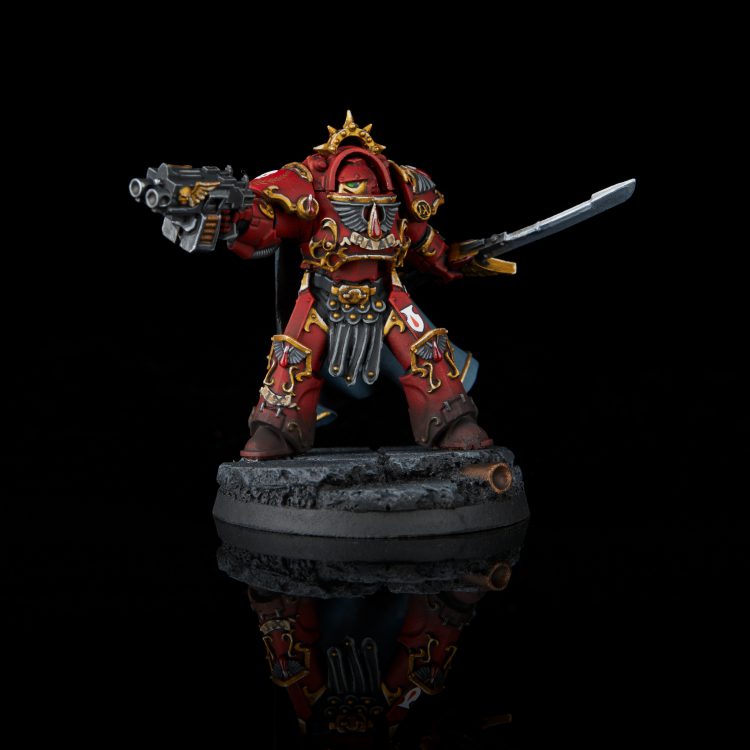
Rites of War
Just because all armies in Horus Heresy are built off the same Primary Detachment doesn’t mean they look the same. Rites of War are the main way that armies get to play with the makeup of their forces, altering what Battlefield Role different units fill, what units have the Line sub-type, how the army deploys, and even some options for units are upgraded. Those bonuses, of course, also come with limitations – Nothing’s free in a galaxy at war!
Having a unit with the Master of the Legion special rule gives you access to Rites of War – a Detachment with at least one unit with this rule may select a Rite of War. Most of the time, this will be a Praetor you take as one of your HQ choices, though most legions also have unique characters with the rule. You can take one Master of the Legion unit per full thousand points you take – so a 750 point army can’t take any, and a 3,000 point army can take three (this means you can’t normally select Rites of War in games under 1,000 points). You can get around this through the Delegatus Consul which gives you access to a rite of war at lower points; we’ll be covering Consuls and other HQ’s in a separate article.
The Rite of War you select for a Detachment only applies to that Detachment, and different detachments can have different Rites. If you’re taking an army with a Primary detachment and an Allied detachment, as long as both have a Master of the Legion, they can each select a different Rite of War.
Most players will want to select a Rite of War for their army any time they’re playing a large enough game to unlock them (and the core rules strongly recommend playing games between two and three thousand points). One Rite, Pride of the Legion, is something any new player just starting with the Age of Darkness box should strongly consider. It works well with all the units in the box, and none of the penalties will apply to your force.

Generic Rites of War
There are nine “core” Rites of War available to all legions in both the Liber Astartes and Liber Hereticus books (and they’re identical in both books). These cover the broad strokes of different fighting styles that any of the Space Marine legions used during the Horus Heresy. In addition to these, each legion also has its own dedicated Rites of War detailed in their sections of each book that cover their own unique tactics and methods of warfighting. We’ll be covering those later in individual Legion Focus articles.
Legion Recon Company
The recon company shifts your compulsory Troop choices away from your traditional Tactical, Breacher, or Assault Marines towards Reconnaissance and Scout Squads. With the Scout and Infiltrate special rules these units will be able to deploy well up the field, then reposition before the game begins (but after you know who’s going first), to either open up shots on characters or move to a more defensive location. This Rite of War also gives you a re-roll to Seize the Initiative, which improves your chances of going first to about 57%, so the nemesis bolters you can give those squads may cause your opponent to start the game without some of their squad sergeants!
As a primary detachment this Rite could be a bit hard to use but would make an extremely effective Alpha Legion or Raven Guard Allied detachment.
Angel’s Wrath
If you’ve read almost any of the Horus Heresy novels, you’ll have experienced one of the most stunning space marine deployments – massed flying transports dropping squads in a shock assault. This Rite opens this up as something to shape your whole army around. Any of your units that can normally take a Rhino as a Dedicated Transport can instead take a Storm Eagle – but any infantry without a jump pack must start the game in a flying transport, and any jump pack infantry must start in reserve. All your flying vehicles can come in from reserve on the first turn without a dice roll, which gives you an extremely reliable way to make sure you only face one turn of shooting before deploying your cargo, even if you go second.
There two big downsides to this Rite: First, you start the game with almost nothing on the board, just dreadnoughts from your primary detachment and any allied detachment you might take. Second, you have to build multiple Storm Eagles, and that’s a fate I’m not sure I can wish on anyone.

Sky-Hunter Phalanx
When you really, really, really don’t want to actually touch the ground, the Sky-Hunter Phalanx is your choice of Rite. Both Sky-hunters (jetbikes) and Land Speeder Proteus squadrons move from Fast Attack to Troops in this Rite and gain the Line sub-type, but your other vehicle choices must be either Flyer, Fast, or Skimmer. Any infantry you take have to start embarked in a flying transport, and you don’t get to take any dreadnoughts. Sky-hunters and land speeders both get a wide range of weapon types, making an army using this Rite incredibly mobile and able to deliver weapons exactly where they need them, at the expense of not having many bodies. Perfect for a White Scars army, if you’re not interested in their bespoke Rites.
Drop Pod Assault
Drop Pod Assaults are another true classic of Space Marines, particularly for anyone who remembers the opening cinematic of Dawn of War. This Rite really does what it says on the tin – you swap Rhinos and Land Raiders for Drop Pods and Dreadclaw Drop Pods, and dreadnoughts can only be taken singly and must have a Dreadnought Drop Pod or Dreadclaw Drop Pod. Anything that isn’t in a drop pod of some sort has to be placed into reserve and can’t be deep striking or flanking on its own.
The drop pod assault itself is a very wordy thing, occurring at the very beginning of your first turn with only the first drop pod scattering. After that, assuming the drop isn’t Disordered you get to place any other pods within 24” of the first – but on a Disordered drop your opponent gets to position them!

Pride of the Legion
This was an absolute staple Rite during the first edition of the game and is going to continue to be so throughout this edition. Your various flavors of Legion Terminators and Veteran Squads become Troops, with any taken as your Compulsory selections also gaining the Line sub-type (so two of your squads will be Line). Any fancy legion-specific terminators you have can also be taken as Troops, though they can’t gain Line. On the downside, you only get one Fast Attack and Heavy Support choice and have to go infantry-heavy.
None of the limits are too harsh and make this a perfect Rite to take with the Age of Darkness box – turn one squad of Tactical Marines into Veterans, take them and the 10 strong Cataphractii squad as your compulsory troops, and give the Cataphractii the Spartan as a dedicated transport. You end up with some very durable Line choices and easy future expansion as you’ve only used one Elite choice and neither your Fast Attack or Heavy Assault.
Outside of the Age of Darkness box this Rite is great for any legion that has a strong way to upgrade their basic terminators. Imperial Fists, for example, can add Vigil Pattern Storm Shields to a big terminator squad, giving them a 3+ invulnerable save and making them a scoring unit that’s incredibly hard to shift.
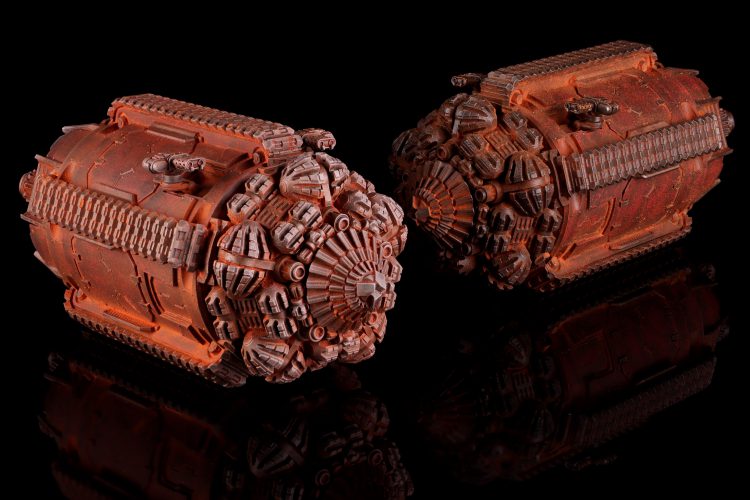
Underworld Assault
Roughly the opposite of a Drop Pod Assault, these drills are arriving from below the surface rather than falling from space. Any of your infantry that aren’t Bulky (generally, any infantry that aren’t terminators or wearing a jump pack) have to start the game in Termite Assault Drills, while anything that isn’t in a drill must start on the board (but gains Stubborn until the assault arrives).
Much like with the drop pod assault, you’re going to want to read the entire rule, as it takes up most of a page. While the drills don’t arrive on the first turn, they do arrive more tightly grouped than the drop pods and can do significant damage to nearby units on arrival. Piling a bunch of short range units into your opponents face all at once is absolutely devastating, whether through Tactical Support Squads full of plasma guns or Heavy Support Squads carrying heavy flamers.
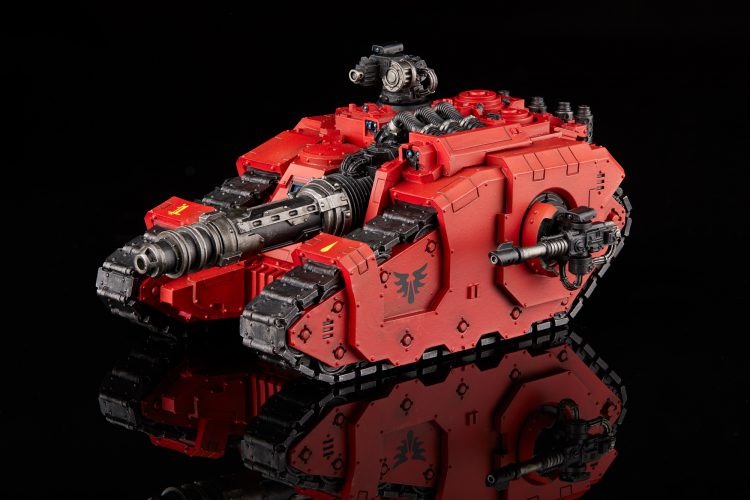
Armoured Spearhead
If you absolutely need to be a coward, hiding inside your perfidious “tank” as the real heroes die on their feet in the trenches, then this is the Rite for you. Your units in Rhinos can take Land Raiders instead, your Predator Squadrons can be taken as troops, and your Sicarans can be taken as Elites. You also must take a Predator or Sicaran as your warlord, and they get some sweet buffs to represent being a leader. All your infantry (and you will want some Troops choices as your Predators don’t get Line), have to start inside some sort of metal box or they get removed as casualties.
While any and all legions do use this kind of armored spearhead, this is particularly well suited to the Iron Hands, Iron Warriors, or Death Guard, all whose legion traits and upgrades are well suited to fielding vehicles. Consider filling some of those Land Raiders with cheap and simple Despoiler squads, as their weight of melee attacks will help you clear out infantry and keep your armor from getting bogged down.
Brethren of Iron
At the moment, this Rite isn’t particularly functional, as we don’t know what Liber Mechanicum looks like or how the various Legio Cybernetica units will work. What we do know is that you need to take both a Praetor and Forge Lord consul, will need a number of techmarines, and can bolster your numbers with a variety of Automata. We’ll come back and update this entry when Liber Mechanicum releases.
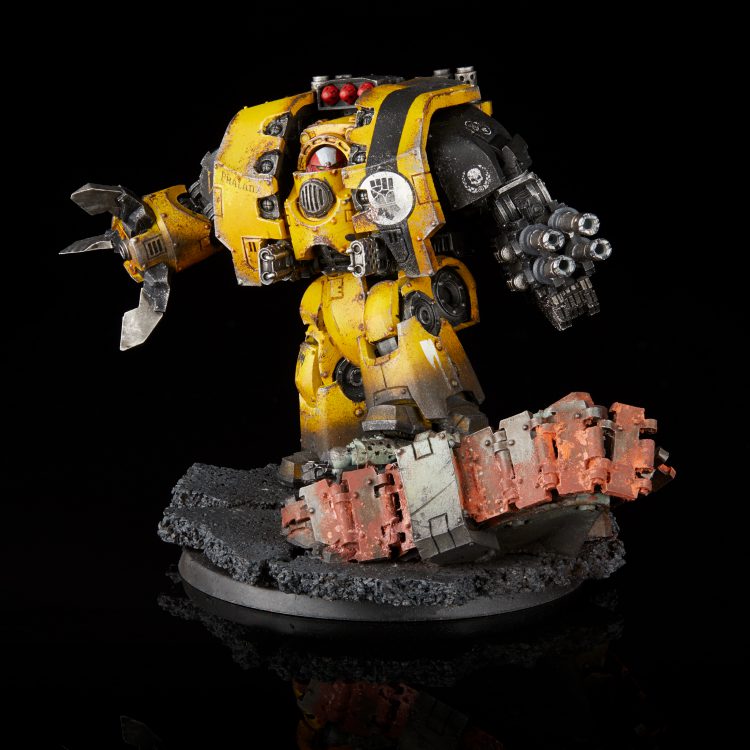
Fury of the Ancients
The last of the generic Space Marine Rites of War, Fury of the Ancients fills your entire army out with dreadnoughts. Your Compulsory troops must be Contemptor Dreadnought Talons, both of which will gain Line. You also get to upgrade one Contemptor to be a Venerable Ancient, increasing its invulnerable save and turning it into a character.
While this could be fun in almost any legion, it’s particularly interesting for Blood Angels as they have their unique Contemptor Incaendius in the Fast Attack slot. Normally a Fury of the Ancients detachment would only be able to take one unit there, but that doesn’t apply to dreadnought units and those contemptors fill the very useful role of being an extra fast blender.
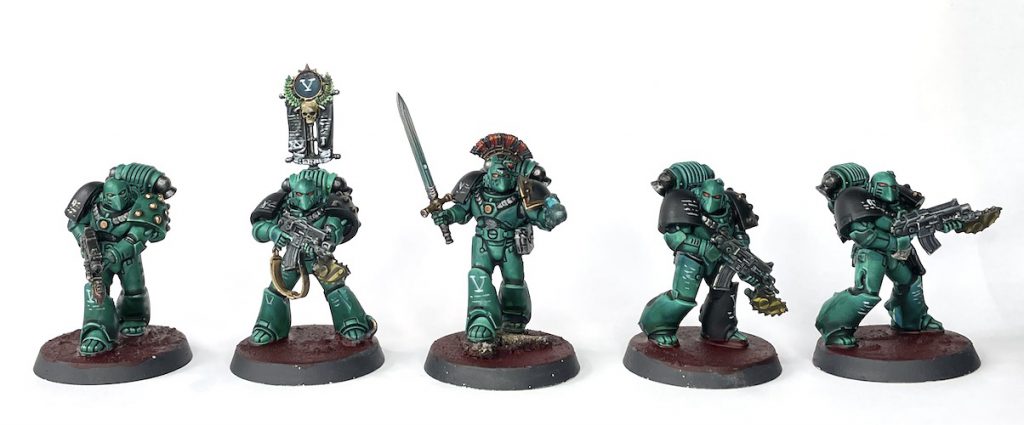
To War!
These nine Rites of War fill out all the generic choices available to any legion. Each legion gets at least one additional Rite tailored specifically to its fighting style if none of the above appeal to you. It’s also entirely possible to play without taking any Rites. As they all have their different limitations, doing so isn’t any worse, just another option.
When we return next time we’ll be taking a look at the different HQ options available to the Space Marine Legions and all the different ways they can help shape your army. Between Rites of War and HQ options, even two armies from the same legion can play extremely differently.
Have any questions or feedback? Drop us a note in the comments below or email us at contact@goonhammer.com.


